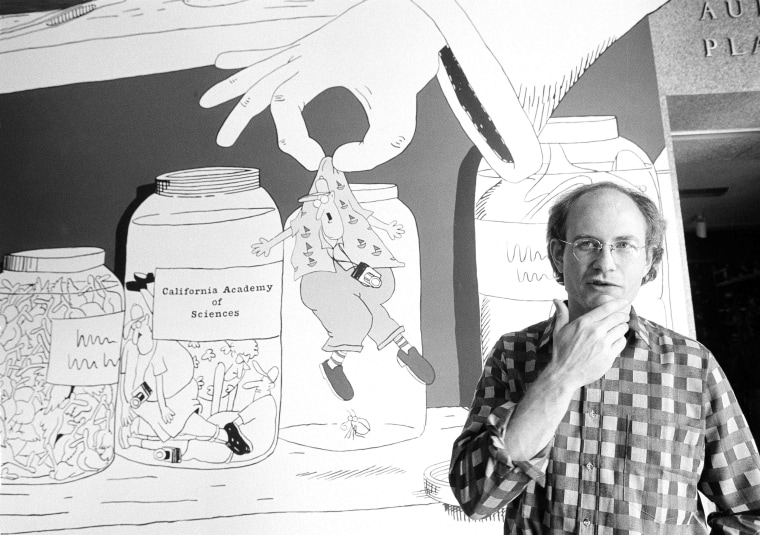Not many cartoonists remain from the last golden era of newspaper comics, but one of the best — maybe the best — has returned: Gary Larson of "The Far Side" published new comics online Tuesday. Larson is also putting up selections of his old strips (all apparently free and with minimal ad presence) and of his sketches.
It’s the sort of thing every dork who was 14 in 1995 (disclosure: me) dreamt of seeing when Larson announced his retirement and vanished into the pre-internet ether, a J.D. Salinger of sentient bugs and cows.
Blessedly, whatever was wrong with Larson when he dreamt up praying mantis dinner parties has not gotten any better. His gags are still extremely silly, none are exactly explicable and now there are more of them.
Not everything enjoyable when you were young remains funny or entertaining when you age, even if you can remember having laughed at it before. Since roughly the turn of this century, pop culture has been archived with incredible speed and sold in forms that privilege a kind of permanence much of it was never meant to have. Comic books that were pulped by the millions 60 years ago are now available to the general public in dust-jacketed, slipcased hardcovers, their original colors garish and weird on archival paper. Once-disposable sitcoms are available in special edition collectible box sets and rebroadcast on demand on a number of streaming services that vie for the rights to "The Beverly Hillbillies" in complex contract wars. (I personally purchased the full archive of "Pee-Wee's Playhouse" on Blu-ray; I regret nothing.)
This is mostly a good thing, as far as I’m concerned: I like my leatherbound Batman comics; I usually don’t mind the recycled gags in old TV shows. Plus, the unexpected permanence of so much entertainment lets us read and watch old material to sample and understand both the past and who we were in it. It rarely bothers me in the moment that old episodes of, say, "Taxi," have their regressive gags. But, then again, entertainment — especially comedy — from our formative years can be embarrassing. Did I once laugh at a mean joke about gay people in front of a friend who later came out of the closet? Did I once adopt that especially cruel imitation of a disabled person I saw there to amuse a friend later? Norms have changed, and not just on "Cheers."
Want more articles like this? Follow THINK on Instagram to get updates on the week's most important cultural analysis
But that's part of what makes "The Far Side" different, even today: It was so weird and so off-topic that even as everyone aged, the comedy didn't.
His reference points weren't — and still aren’t — reality TV or politics, but the mating and eating habits of carnivorous insects, the ridiculousness of dogs or the perversity of cow tools — a cartoon so silly that it was pulled by The Lexington Leader of Kentucky, which later felt obliged to run a piece about its removal. It said it had done so “because we didn’t understand the gag,” according to then-editor Steve Wilson. (In typical self-deprecating fashion, Larson includes the article, which notes that his mom didn’t like the cartoon, either, in his compilation book "The Complete Far Side," which is the size and shape of the Oxford English Dictionary.)
In his 2013 New York Times profile of legendary comedy writer Jack Handey (perhaps best known among noncomedy writers for his "Deep Thoughts" interstitials on "Saturday Night Live" in the 1990s), writer Dan Kois said that interviewees kept on telling him that Handey could write “pure” comedy. “It seemed as if to them Handey is not just writing jokes but trying to achieve some kind of Platonic ideal of the joke form,” Kois writes. Larson is doing this, too.
Comic strips were, back in the day, a funny business, and it’s hard to overstate how wildly popular "The Far Side" and its syndicated-in-newspapers peers were at the end of the last century. When Larson retired, The New York Times estimated that "The Far Side" had generated $500 million in merchandise sales alone. Thousands wrote letters to Larson and cartoonists like him — or hate mail, in the case of Cow Tools. His contemporary, Garry Trudeau, took a nearly two-year hiatus from "Doonesbury" to turn it into a Broadway musical, where it ran for 13 weeks. (It’s even hard to blame right-wing cartoonist Scott Adams of "Dilbert" fame for his current insufferable presence on social media, as he used to be a celebrity author on the order of Neil Gaiman or Stephen King.)
Larson’s work, though, somehow still transcends the culture that produced it. It’s worth half a billion dollars, but it’s not more complicated or political than a picture of a guy shouting “taxidermist!” at a yellow car filled with dead animals. If you don’t smile at that, I can’t help you.
Related:




